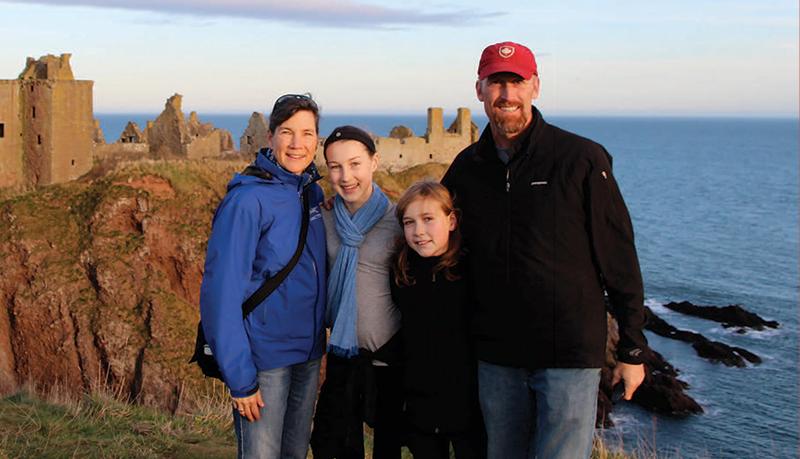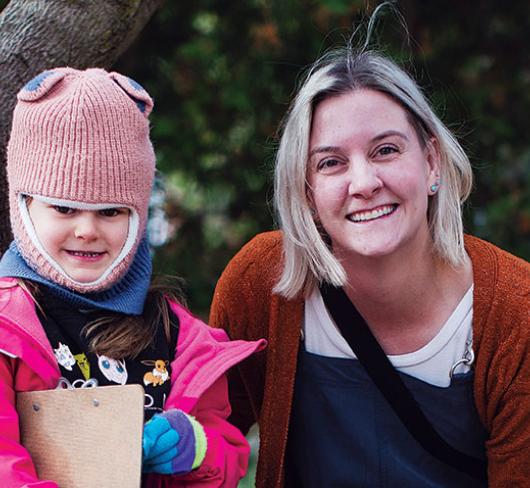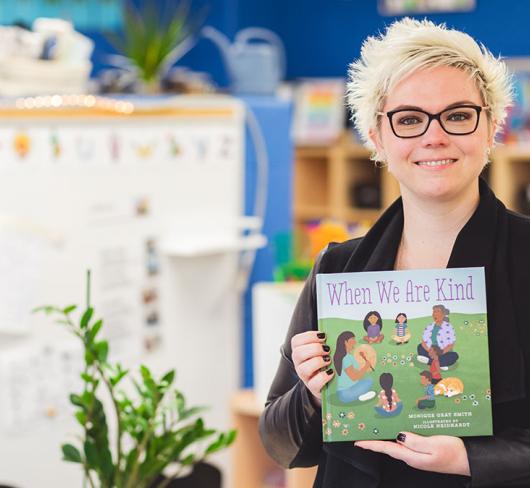
Exploring Scotland on Exchange: An Opportunity for Professional and Personal Growth
As I walked out of the Edinburgh airport on July 30, 2013 and felt the Scottish wind on my face, my dream of doing a teaching exchange became a reality. A year of planning and anticipation of bringing my family of four to Dundee, Scotland was finally unfolding. The regular Skype “dates” with Judith (my exchange partner) and the many hoops I had jumped through had brought me here; I was driving through the beautiful rolling Scottish landscape to my home and the place I would be working with a teacher I had only met “virtually” up to now.
Regular communication with Judith set the tone for a positive relationship and exchange experience. Our conversations, which at first were awkward due to different accents, phrases and unfamiliarity, soon became easier and built excitement for the adventure ahead. Many teacher exchanges don’t begin with this level of communication, and I appreciated it. I also felt fortunate that Judith, who wasn’t leaving for my home in Ottawa until after our arrival in Scotland, took the time to give me a “wee” tour of Dundee and my new school, Ballumbie Primary.
School began within a couple weeks of our arrival. In addition to setting up my classroom, planning lessons and meeting with my stage partner (same grade teacher), we were also faced with the logistics of getting our mobile phones up and running, purchasing and insuring a car, opening a bank account and registering our daughters for school. Early trips to the grocery store took much longer than usual as we figured out products (Haggis-flavoured crisps anyone?), brands and currency. Since we didn’t have a vehicle right away, early trips to school involved navigating public transit, which, though efficient, took time to figure out.
Ballumbie Primary School opened in the spring of 2012. It boasts large windows, skylights and lots of open indoor spaces. A beautiful fused glass installation created by the students for the opening of the school greets visitors in the front entrance area.
In contrast to this inviting welcome is a fence surrounding the entire perimeter of the property, with a locked gate to discourage use of the grounds by the general public. All outside doors are locked during the day, and the only way for parents and visitors to get into the school is through the main locked door. Visitors need to buzz the office to get into the building and are only allowed as far as the reception area (the office). Several doors between the office and my second floor classroom required a security card in order to pass. All of these measures are the residual effects of the Dunblane school massacre of 1996. This high level of security, designed to keep students safe, would prove to be a challenge during the school year. Alarms would frequently interrupt my lessons as outside doors were inadvertently opened throughout the day. High security would be one of the early and lasting differences between my community-oriented Canadian school and my school in Scotland.
Professionally, I had experiences that both supported and challenged my growth. It took me much of the year to accept that while I wanted to do my professional best, I couldn’t wrap my head around a new curriculum, procedures and expectations without often feeling like an overwhelmed first-year teacher. Coming to terms with cultural and academic differences, both on a national and school-based level, was a huge undertaking. From the start, I was told how challenging an exchange year could be, but it was even greater than expected. When I arrived in Scotland, I wanted to be an ambassador and advocate for “all things Canadian.” Eventually, I realized that it would be more appropriate for Judith on her return to Scotland to be the voice of the Canadian system, while I would share my learnings from Scotland with Canadian teachers.
The Professional Experience … Curriculum and Planning
In Scotland, education is a national responsibility and teachers follow a different curriculum from the rest of the United Kingdom. The Scottish “Curriculum for Excellence” divides elementary students into three levels from pre-school to the end of primary school. My students were completing the second level – Primary 7 (Grade 6).
The Scottish school year is more or less the same length as ours in Ontario and is divided into four equal terms. Curriculum experiences and outcomes are similar to those in our Ontario curriculum, although they are much less prescriptive. Units of work are based on student progress through the Curriculum for Excellence and teachers have the freedom to select topics through which they will address curricular outcomes. My stage partner and I planned units together, often based on personal interests. For some lessons (e.g., math and spelling), students were grouped by ability based on assessments by the previous year’s teacher.
As part of the school improvement plan at Ballumbie Primary School, there was a focus on developing strategies for teaching mental math and numeracy. I appreciated professional development (PD) sessions led by Tom Renwick, who encourages students to increase their mental fluency in working with numbers when tackling real-world situations that require math skills.
Each term’s curricular outcomes, activities and evidence of learning were to be laid out in a detailed “Forward Plan” which was submitted to school management and then sent home to parents in the form of a “Big Picture Plan” that includes all areas of the curriculum. At the end of each term, student progress was noted on these plans and a formal feedback session was scheduled for each teacher with a member of the school management team to review plans and student progress.
Assessment and Reporting
In Scotland, students are scored on their level of understanding (Developing, Consolidating and Secure) for each area of the curriculum. Teachers must plan lessons and provide instruction to move each student to the Secure level of understanding. I found that my Scottish students were adept at speaking to their strengths and areas of need, and throughout the year, I learned a variety of systems for empowering students to talk about their learning and personal targets on a regular basis. My exchange experience helped me become more comfortable at identifying, creating and talking about learning intentions and success criteria with students. I was particularly impressed by the school-wide use of personal learning logs for students where they shared and discussed evidence of their learning – a practice I would like to see put in place here at home.
As the locks might indicate, communication with parents outside of formal parent-teacher interviews, was seldom in person. When I had reason to reach out to parents, contact was generally made by the school management team. I sometimes felt out of the loop when I didn’t receive feedback on conversations or have an opportunity to provide input on the next steps that were planned for a student’s success.
With only one formal report card in June, parents or caregivers are informed of their child’s progress through parent/teacher interviews that occur twice yearly, in November and March. The 10-minute meetings take place in the gym hall and address the work and progress of each child. I spent less time preparing for these discussions than writing report cards at home and appreciated the opportunity to meet face-to-face with families twice during the year.
Beyond the Classroom
Each week I had two and a half hours of reduced-contact time (prep time), divided into two separate blocks. During this time, my students received instruction from specialist teachers (e.g., arts, information and computer technology). The reduced minutes of preparation time, as compared to Ontario standards, were balanced by the absence of supervision responsibilities. In Scotland, support staff supervise students during lunch times and recesses.
Scottish teachers are required to fulfill 190 non-classroom hours as part of a Working Time Agreement (WTA). These hours include in-service, staff meetings, extra-curricular activities, after-hours school events and report writing. I was expected to attend weekly staff meetings lasting at least an hour and a half. Throughout the year, five in-service (PD) days were planned, one of which was held before the start of the school year. I appreciated this opportunity to get to know the school and my colleagues before students arrived. The WTA also requires teacher involvement in “working parties” (committees) that address such initiatives as numeracy, an early-intervention literacy program, cooperative learning, student assessment, restorative practices and the promotion of higher order thinking skills. Colleagues meet to plan and provide professional development for the whole staff.
Occasional Teachers
One of my biggest surprises was that teachers are not replaced when they are absent from school. It was common practice for students from other classes to be placed in my class when a teacher was away. On many occasions I had as many as six extra students (not necessarily of the same age or stage) in my classroom. When I missed a day of school to attend an exchange teachers’ conference, my students were divided among several classes and I provided independent work for them for the day.
The Personal Experience …
The personal benefits of the exchange year were immeasurable. The opportunity to live as a resident, as opposed to a tourist, in a foreign country was a unique experience. I loved seeing my daughters thrive in the academic and social challenges that they faced during our exchange year. I was so proud of how they handled these challenges, and I know they will be better people for having had this experience. Our weekends were full of great travel experiences to points in Scotland, both near and far. We hiked the highlands, explored the islands and stepped back in time as we visited dozens of castles, ruins and historic sites. My husband, on a leave of absence from his teaching position, was kept busy planning weekend and holiday sojourns, and managing our “home front.”
Beyond Scotland, we enjoyed the relative nearness of many beautiful and interesting destinations. We spent our October holiday in the Lake District of England and in Ireland, the Christmas holiday in the south of France, and the spring holiday skiing in Austria, hiking in Switzerland and exploring Paris. We travelled to Iceland in May, took two trips to London, and explored the Netherlands by bike and barge. These unforgettable opportunities were ones we would never have experienced living in Canada.
One of the big “take-aways” from the year on exchange was valuing the kindness of strangers. As a family of four, we were quite self-sufficient and socially supportive of each other, but we were also extra appreciative of assistance. We found this social support in unexpected places: friends of friends, the man who sold us our car, an artisan, colleagues and those chance encounters with people who seemed to show up at just the right time. My exchange partner would say that she received the same kindness from family, friends and colleagues, as she lived in our house and taught at my school.
We also found great support and a huge welcome through the exchange teacher clubs. We made a point to try and attend every event that the clubs hosted. Attending the Braemar Highland Games, a pantomime in Edinburgh, a Burns brunch in Dunfermline, weekends in Aberdeenshire and Glasgow, a Fife coastal walk and barbeque, and a farewell barbeque in Ayrshire enriched our year. Not only were we exposed to Scottish traditions and beautiful places, we made some great friends.
I would highly recommend a teacher exchange experience. My year on exchange to Scotland was one of tremendous growth, both personal and professional. As a family, we learned a great deal about ourselves, and other people and places through our adventures and travels. This shared experience brought my family together and created remarkable memories that will be a reference point for the rest of our lives. While there are many ways to teach abroad, such as living on a military base or teaching at an international school, the teaching exchange model placed us in an authentic cultural experience where I was living and working in a Scottish teacher’s house and school. The Canadian Education Exchange Foundation (ceef.ca) provided us with all the information, support and guidance to make this exchange happen, and, for this, we are so grateful.
Michelle Richardson is a member of the Ottawa-Carleton Teacher Local. Her husband David documented her family’s adventures in a blog at moosedroppings.ca.

